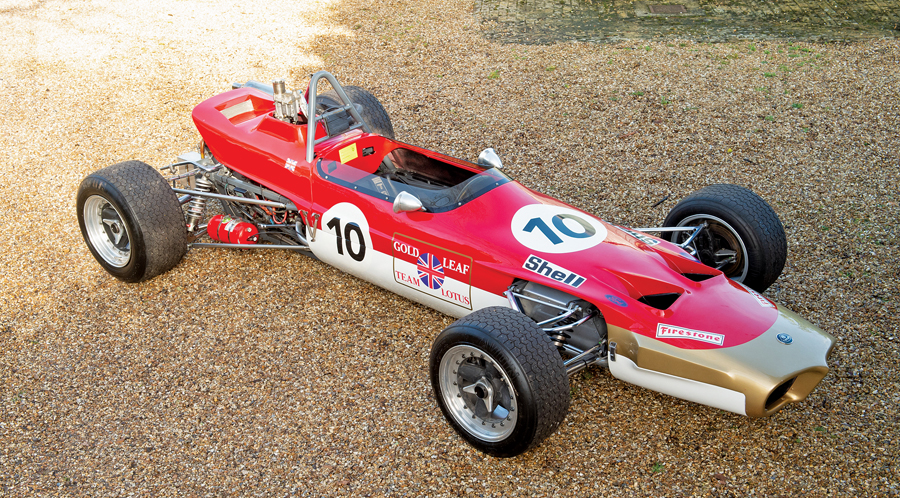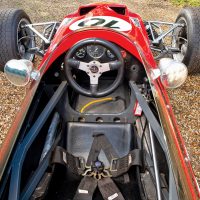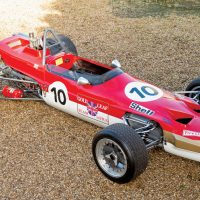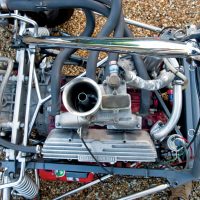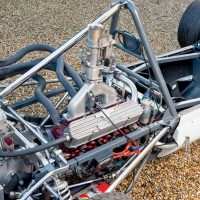SCM Analysis
Detailing
| Vehicle: | 1969 Lotus Formula 3 |
| Years Produced: | 1969–70 |
| Number Produced: | 46 (maybe six to eight Formula 3) |
| SCM Valuation: | $80,000 (this car) |
| Chassis Number Location: | Tag on frame, engine bay |
| Engine Number Location: | Boss at left front of block |
| Club Info: | Formula Regional European Championship |
| Website: | http://www.acisport.it/en/FORMULAREGIONAL/home |
| Alternatives: | 1967 Brabham BT 21F3, 1968 Matra MS5 F3, 1969 Techno F3 |
| Investment Grade: | B |
This car, Lot 107, sold for $82,674, including buyer’s commission, at Bonhams’ Goodwood Members’ Meeting auction in Chichester, U.K., on April 7, 2019.
For most racers, horsepower is a seductive lover, stroking the ego with rushes of adrenaline and testosterone as it invites you to explode out of a corner exit and hurtle toward the next turn — exuding excitement and glory in your quest for victory.
The problem is that, attractive and seductive as it is, horsepower is not very good if the intent is to really learn the craft of race driving.
The essence of the race-driving craft is to get a given vehicle around the track in the absolute minimum amount of time. This involves a number of unforgiving requirements:
Never slowing down more than necessary, and doing so at the latest possible time.
Carrying every possible unit of momentum through the corner and onto the next straight — and exiting without scrubbing energy because every foot per second translates to how quickly you get to the next corner.
Keeping the engine “on song,” so it can provide maximum power in an instant — and on and on and on.
Having extra horsepower allows a driver to cover any sloppiness or imperfection in his driving, which isn’t the way to really learn.
The minor leagues
Ever since the 1950s, small-horsepower formula cars have been the training ground for almost all of the great racers. Moss, Brabham, Clark, and Graham Hill all started their racing careers in the Formula 3 of their time. In the early post-war period, Formula 3 was 500-cc motorcycle engines in minimalist chassis, often homebuilt or from the likes of Cooper — cheap to buy and run and not very fast, but intensely competitive.
It was almost exclusively a British class, which lacked appeal to the newly internationalizing post-war Europe.
In 1958, Count Giovanni Lurani suggested adding a new class, Formula Junior, to FIA racing with the express intent of providing an affordable way for new racing drivers to learn the skills in races across Europe.
Lurani’s concept was to create a relatively stable formula, but it had the luck to mature just as the mid-engine revolution swept Formula 1.
By 1960, front-engine cars were a memory while British manufacturers were offering one-liter (or 1,100-cc) versions of their Formula 1 designs.
The arrival of Ford’s “Kent” 4-cylinder engine, with an eight-port head, five-main bottom end and external oil pump (to allow easy dry-sump conversion) pretty much finished off any other options, and with free carburetion (Webers), the engines made an easy 120-plus horsepower.
By 1963, with the introduction of Lotus’ monocoque Type 27, Formula Junior had abandoned any technological stability or affordability. The joke at the time in the U.S. was that if you bought a new Junior in the U.K., it had to be air shipped back, because if it went by ocean it would be obsolete by the time it arrived.
A new formula was needed
After 1964, Formula Junior was abandoned as an FIA championship class. It had simply become too expensive as a training formula.
There remained a need for a development class, so Formula 3 was revived. It was still pretty much Formula Junior, but monocoque chassis were outlawed in favor of cheaper and more easily repaired tubular frames. The big change was engines, which were still production-based 1,000 cc — but with extensive modifications allowed. Carburetion remained free, but all intake air had to pass through a single 36-mm orifice, which eliminated multi-throat Webers.
Cosworth responded by creating the MAE engine (Cosworth nomenclature always means something, in this case “Modified Anglia Engine”), which modified the intake ports so they were far more efficient.
The MAE made 111 hp at 8,300 rpm but was barely able to keep running below 6,000, which quickly gave the new Formula 3 class the nickname “Screamers.”
Formula 3 was where the serious professional racers of the future honed their skills. If you were aiming at Formula 1, success in Formula 3 is where you started. Brabham, Cooper, Lotus and Italy’s Techno, all with Formula 1 involvement, were the constructors and teams that mattered in the late 1960s.
Lotus’ entry into this category was the Type 59, a very conventional — but competent — chassis that was built, depending on engine, tires, and some minor details, as Formula 2 (Cosworth FVA), Formula 3 (MAE), Formula B (Lotus Twin cam) or Formula Ford (Ford Crossflow). It was known as a superb handling chassis, particularly on rougher tracks. Lotus built about 46 of them. I have no idea how many were in F3 configuration, but not many, maybe six or eight.
Hard driving
Except for Formula 1 itself, Formula 3 was the most competitive and relentless class in automobile racing at the time. Only the best young drivers were there, and nobody had any mechanical advantage — same horsepower, same weight, same brakes, same tires. The races were flocks of Screamers drafting each other in a tight bunch, each waiting for the other to make the slightest miscalculation with the dream of a Formula 1 career on the line. Any misstep cost two or three positions that were all but impossible to recover.
Vintage Formula 3 is a very real, if minor, component of current European racing. Most of the racing is in France, with a few races in the U.K., and it is every bit as serious as it was in its day.
If you are hypercompetitive and willing to prove your stuff against the best on an absolutely flat playing field, Formula 3 is a great place to do it. It is relatively inexpensive, as the cars generally carry little — if any — collector value. The engines are small and simple — and the chassis easy to repair. Values generally run between $60,000 and $95,000 per my sources.
A tough market
There never were a lot of Formula 3 cars, and the group that races them is relatively small, so these are difficult things to sell. There isn’t enough money in them to be worth a broker’s time, and auctions are notoriously bad places to sell weapons-grade racers. That isn’t always true, though, and this car’s seller was either very astute or well advised.
There was probably no better venue in the world to sell this particular car: It is associated with a major racing event, and they even had a Formula 3 grid, so all the right people were there. If it was going to sell, this was the place.
The car was known as mechanically excellent, with unquestioned provenance — and the presentation was impeccable.
As a Team Lotus car, it possibly carried some collector value — and certainly important livery. It sold right in the middle of the expected range. It was a limited-interest car, fairly bought and sold in the right place. ♦
